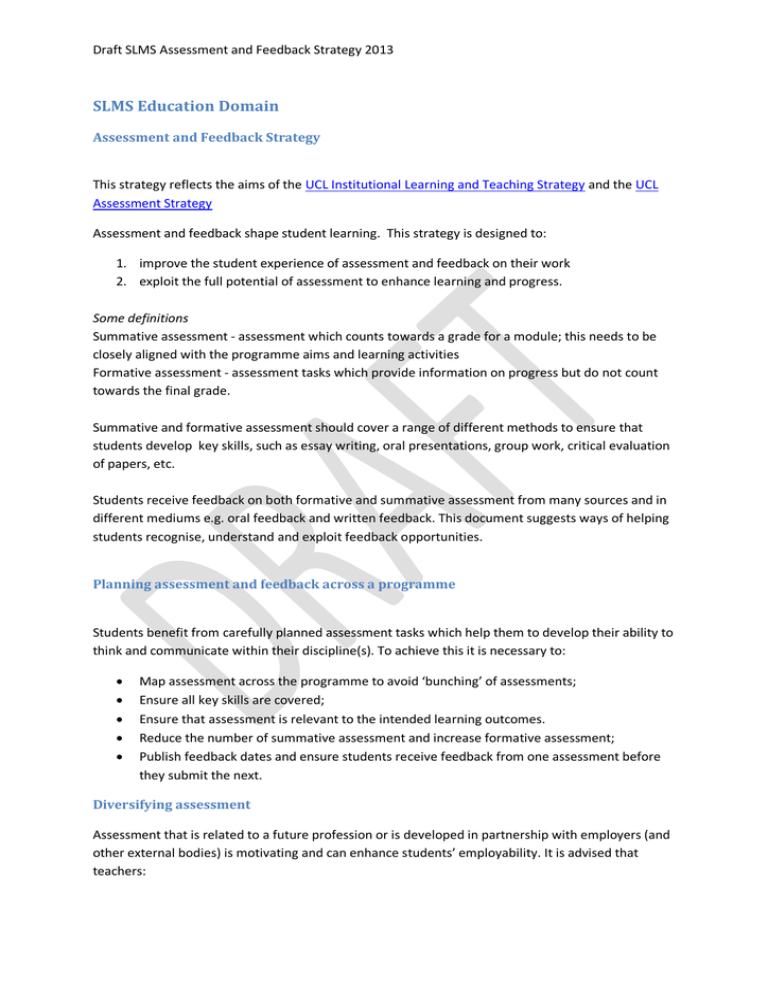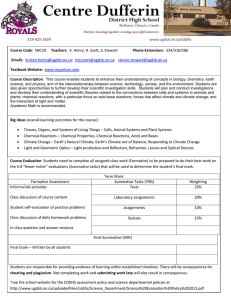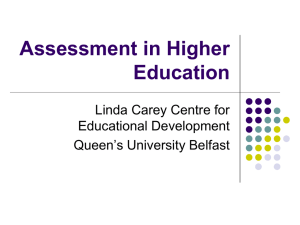SLMS Education Domain
advertisement

Draft SLMS Assessment and Feedback Strategy 2013 SLMS Education Domain Assessment and Feedback Strategy This strategy reflects the aims of the UCL Institutional Learning and Teaching Strategy and the UCL Assessment Strategy Assessment and feedback shape student learning. This strategy is designed to: 1. improve the student experience of assessment and feedback on their work 2. exploit the full potential of assessment to enhance learning and progress. Some definitions Summative assessment - assessment which counts towards a grade for a module; this needs to be closely aligned with the programme aims and learning activities Formative assessment - assessment tasks which provide information on progress but do not count towards the final grade. Summative and formative assessment should cover a range of different methods to ensure that students develop key skills, such as essay writing, oral presentations, group work, critical evaluation of papers, etc. Students receive feedback on both formative and summative assessment from many sources and in different mediums e.g. oral feedback and written feedback. This document suggests ways of helping students recognise, understand and exploit feedback opportunities. Planning assessment and feedback across a programme Students benefit from carefully planned assessment tasks which help them to develop their ability to think and communicate within their discipline(s). To achieve this it is necessary to: Map assessment across the programme to avoid ‘bunching’ of assessments; Ensure all key skills are covered; Ensure that assessment is relevant to the intended learning outcomes. Reduce the number of summative assessment and increase formative assessment; Publish feedback dates and ensure students receive feedback from one assessment before they submit the next. Diversifying assessment Assessment that is related to a future profession or is developed in partnership with employers (and other external bodies) is motivating and can enhance students’ employability. It is advised that teachers: Draft SLMS Assessment and Feedback Strategy 2013 Use authentic assessment (closely related to key skills and professional tasks) wherever possible Ensure that assessment tasks enable students to demonstrate higher order learning (application, problem-solving, critique) rather than recall of factual knowledge Vary assessment tasks over a programme; include individual and group tasks and oral and written work. Reduce reliance on exams and MCQs; increase or introduce coursework. Developing students’ understanding of assessment and feedback It is essential that students are made aware of the different types of assessment and what key skills are being assessed in each module. Programmes need to: Improve students’ understanding of assessment criteria and how they are used to evaluate the quality of work. For example, through guided marking (where students mark and discuss a range of their peers’ assignments from a previous year) and through peer review and peerassessment; Give students practice in the tasks they need to do for summative assessment. Ensure that students practise any new form of assessment before it ‘counts’; Students should be aware of how they have used feedback to improve their next assignment. Improving marker reliability Markers benefit from comparing and sharing their judgements. This is especially important for those new to marking such as teaching assistants and early career academics. Programme leaders need to: Ensure markers have a clear understanding of the marking scheme. Give assessors/examiners the chance to standardise the application of assessment criteria to students’ work (to increase the reliability of assessment) through regular standardisation meetings where markers grade and compare comments on a range of student assignments. Ensure markers give individual feedback at the appropriate time. Ways of implementing and suggested time frame: Dates Activity By August 2014 Assessment and feedback strategy to be discussed at departmental teaching and learning Away Days or similar event. Opportunity to discuss/amend/agree strategy. Action plan to be submitted to DTC and FTC. Report to Education Domain HoDs/Faculty Tutors to report to the Education Domain Draft SLMS Assessment and Feedback Strategy 2013 Mapping and action plan completed by September 2015 By 2015-16 Map assessment across the programme (by January 2015, in time for change of assessment forms to be approved). Review assessment and produce action plans, where necessary, to reduce summative assessment, increase formative and align assessment tasks and learning activities with programme aims. Develop new assessment methods if necessary to diversify assessment and reduce reliance on MCQs and exams. Increase student understanding of assessment processes and criteria by giving them the opportunity to carry out guided marking, peer review and assessment, and self assessment. Introduce standardisation meetings for all programmes. This involves teachers meeting before marking to check that there is a shared understanding of how assessment criteria will be applied, using examples of student work. (see ‘Improving Marker Reliability’ above). HoDs to report to Education Domain FTCs to monitor. Faculty Tutor to report to Education Domain Resources: Hyperlinks to info about Transforming the Experience of Students Through Assessment (TESTA) and Identifying skills learning: Active and object-based learning (OBL)



